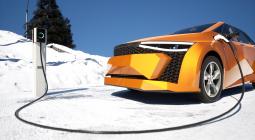2025 tipped to be bumper year for EVs as emission laws change and new models arrive
Emissions caps to come into effect on 1 January for commercial fleets, utes and big 4WDs
Electric utes, vans and sports cars from a wide range of automakers will roll into Australia over the next 12 months in what is expected to become a milestone year for low-emission vehicles.
Automotive industry experts say the race will be triggered by laws that set a pollution cap on new vehicles in Australia for the first time, catching up to regulations in other countries.
But they warn a late start for their enforcement and tough economic conditions could slow Australia’s progress towards electric car targets.
The New Vehicle Efficiency Standard will come into effect from 1 January, setting a pollution limit for fleets of passenger vehicles and another for light commercial vehicles such as utes and large four-wheel drives.
The limits will apply to new cars and are designed to encourage automakers to balance sales of high-polluting vehicles with low-emission electric and hybrid models.
But the standard has affected the local vehicle market before its official arrival, Australian Electric Vehicle Association national president Chris Jones said, as many emerging and established brands had announced plans to import electric and plug-in hybrid electric cars.
“It’s going to be an exciting year and there will be lots more makes and models hitting our shores,” Jones said.
“We’ve always been a very diverse, competitive passenger vehicle market.”
Reaction to the launch of BYD’s Shark 6 plug-in hybrid ute, which attracted almost 4,000 pre-orders, showed Australian motorists were eager to adopt low-polluting vehicles, Jones said, but were waiting for options that suited them.
Australians should expect to see a lot more electric challengers arrive in 2025, Swinburne University future urban mobility professor Hussein Dia said, including some with competitive prices.
“There will be an influx of cheaper vehicles and models from China,” Dia said.
“They are challenging many of the established brands and we’ve already started to see their impact in Australia.”
Lesser known brands such as Zeekr, Smart and LDV planned to bring electric cars to Australia during the year to compete with launches from European companies like Polestar and Volkswagen, and well-known Asian brands such as Hyundai and Kia.
New electric and plug-in hybrid vehicles expected to arrive in Austyralia in 2025 include Volkswagen’s minivan ID.Buzz, Zeekr’s sleek X SUV, Hyundai’s compact Inster and Kia’s EV3 SUV.
Newer brands could set price records for electric cars that fell during 2024, Dia said, and could boost sales for entry-level and luxury vehicles.
“Some of the models we’re expecting from China, for $50,000 or $60,000 you can get what is comparable to a luxury brand,” he said.
“That could take off.”
Penalties for exceeding pollution limits will not be enforced under Australia’s vehicle efficiency standard until July, however, and some light commercial vehicles weighing between 3.5 and 4.5 tonnes will not immediately be required to go through carbon testing.
The “loophole” should be closed quickly to prevent misuse, Jones said.
Cover photo: BYD’s Shark 6 plug-in hybrid ute has attracted almost 4,000 pre-orders in Australia. Photograph: BYD




